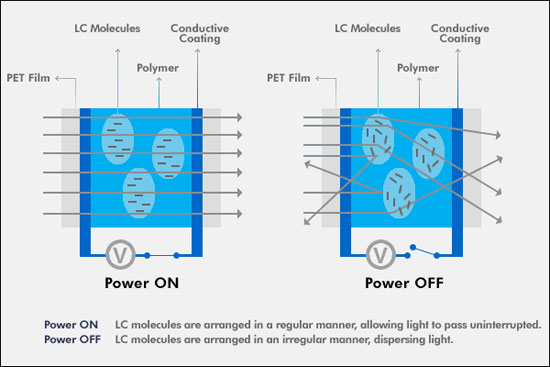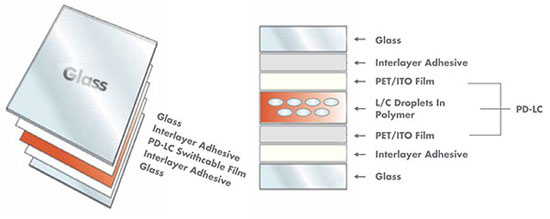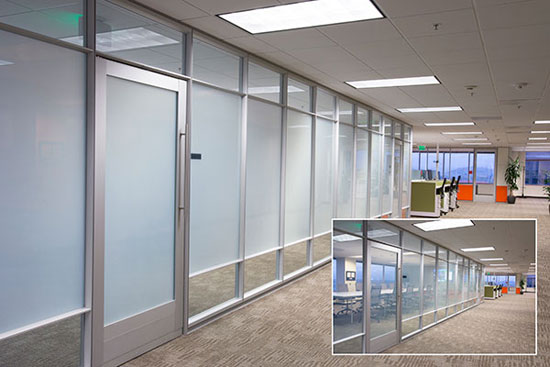Smart Glass Applications with Polymer Dispersed Liquid Crystal (PDLC) Technology
How PDLC Technology Works
Liquid crystal applications are a familiar technology for numeric and flat panel displays. Liquid crystal display, or LCD, is the most popular flat panel display technology, seen in portable computers, cell phones, calculators, digital clocks, gas pumps, and watches, etc. In LCD, applied electricity changes the shape of liquid crystals to allow light to pass through individual elements, thus forming images, figures, and numbers on the displays.

Image courtesy of Glass Apps.
Liquid crystals respond to an electrical charge to morph the glass from opaque to clear.
Source: http://www.glass-apps.com
Polymer dispersed liquid crystal is simply micro droplets of liquid crystals encapsulated in a polymer matrix. The liquid crystals respond to an electrical charge. In a static state, the liquid crystal molecules remain in a randomized configuration that refracts the light that enters the mixture, making it appear opaque. When electricity is applied, the molecules line up the direction of the electric field, allowing light to pass through what is now essentially a transparent surface. When electrical charge is deactivated, liquid crystal droplets again become randomly oriented, the incoming light is again heavily scattered and does not pass through in a straightforward manner, resulting in fully blocked images.
Types of PDLC Switchable Glass
Smart glass with PDLC technology is available in two separate products that help to solve distinct design problems.

Image courtesy of Glass Apps
The layer containing indium tin oxide (ITO) conducts the electricity that stimulates the liquid crystals.
Laminated Switchable PDLC Glass
Laminated switchable glass is typically used for new construction projects or renovations where glass may be replaced. In this case, switchable film is sandwiched between two sheets of glass and two sheets of interlayer adhesive. Indium tin oxide (ITO) is a clear conductor that is coated on the inside of PET plastic films, which are sandwiched around the LC droplets encapsulated in a polymer matrix. PET/ITO films conduct the electrical current that causes the liquid crystals to align and thus render the glass transparent. Glass can be made to almost any thickness (5/16” to + for Insulated Units) and specification required (i.e. tempered, low-iron, etc.).
Self-adhesive Switchable PDLC Film
Self-adhesive switchable film is typically used for retrofit applications. Switchable adhesive film has an adhesive side that is dry applied to the surface of any smooth glass surface (similar to a smart phone screen protector) and can be easily installed in the field. The outer surface of the film is hard coated and scratch resistant. Copper mesh tabs on the top or sides connect the conductive layer to electrical wires soldered on by the installer, covered by a silicone bead, and attached to a power source. The electrical current can be controlled by a wall switch, home automation or smart phone app.
With the knowledge of how PDLC technology works, we’ll next examine the benefits it brings.










